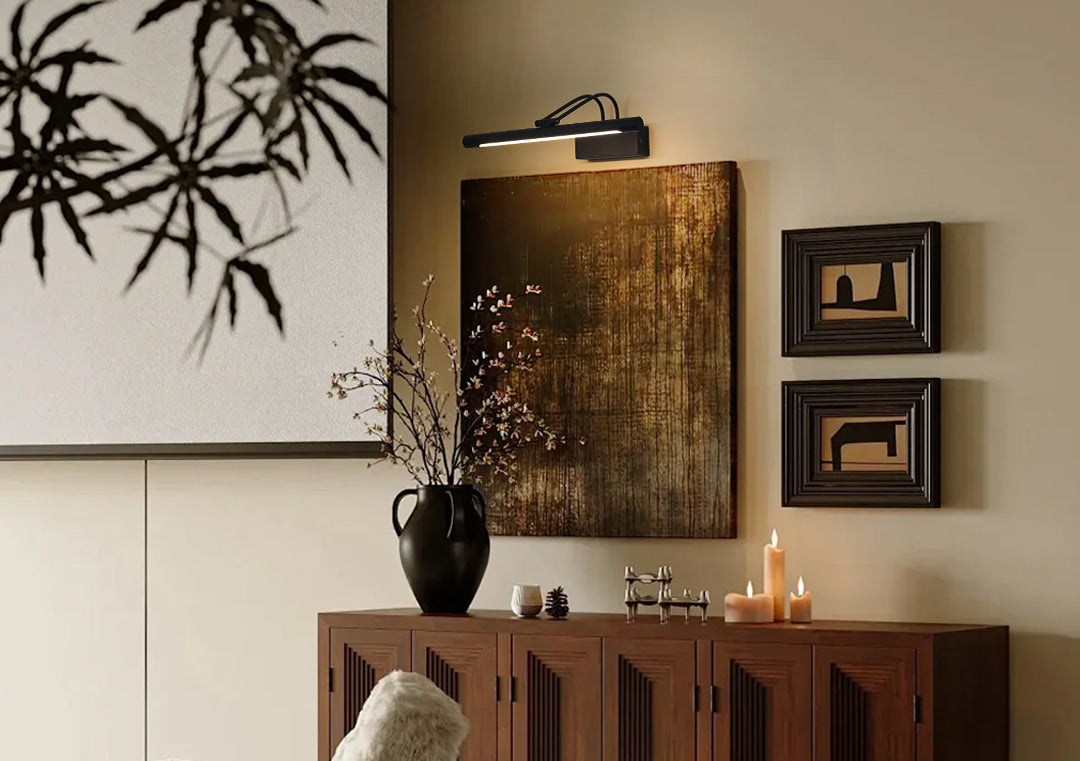Selecting the right color temperature for your led lighted pictures is a crucial consideration to enhance the visual appeal of your artwork while creating the desired ambiance in your space. Color temperature is measured in Kelvin (K) and determines the warmth or coolness of the light emitted by a bulb. Here's a guide to help you understand the impact of color temperature on picture lighting.
1. Warm White (2800K-3000K):
Warm white light creates a cozy and inviting atmosphere. Picture of led lights with a color temperature in the range of 2700K to 3000K emit a soft, golden glow that enhances the warmth and richness of colors in your artwork. This temperature range is well-suited for traditional or classic spaces, creating a comforting and intimate ambiance.

2. Neutral White (3500K-4000K):
Neutral white light strikes a balance between warm and cool tones. With a color temperature in the range of 3500K to 4100K, this lighting provides a clea and natural appearance. It works well for showcasing artwork with a broad spectrum of colors, making it a versatile choice for various styles and settings, including contemporary and transitional spaces.
3. Cool White (5000K-6500K):
Cool white light has a crisp and energizing quality. Picture lights with a color temperature in the range of 5000K to 6500K emit a brighter and cooler illumination. This temperature range is ideal for contemporary and modern settings, where a clean and vibrant lighting effect is desired. It enhances the clarity and detail of artwork, making it suitable for spaces where a more dynamic atmosphere is preferred.

Warm vs. Cool Colors:
Colors are often categorized as warm or cool. Warm colors (reds, oranges, yellows) evoke feelings of warmth, energy, and vibrancy. They are associated with coziness and can make a space feel inviting. Cool colors (blues, greens, purples) create a sense of calmness, serenity, and spaciousness. The choice between warm and cool lighting depends on the desired mood for a particular space.

Color theory in lighting
Color theory in lighting is a fascinating aspect that significantly influences the mood, atmosphere, and aesthetics of a space. Understanding how different colors interact and impact our perception can help in creating visually appealing and harmonious lighting designs.

1. Basics of Color Theory:
Color theory is built on the color wheel, which organizes colors based on their relationships. Primary colors (red, blue, and yellow) form the foundation, and secondary colors (green, orange, and purple) result from mixing them. Tertiary colors are further combinations. Complementary colors, positioned opposite each other on the wheel, create a vibrant contrast.
2. Psychological Impact:
Different colors can evoke specific emotions and moods. Warm colors are often associated with energy, passion, and intimacy. Reds and oranges can stimulate and create a sense of excitement. On the other hand, cool colors are linked to calmness, tranquility, and focus. Blues and greens can promote relaxation and concentration.
A color temperature of 2800K is ideal for art displays.
Proper lighting balance between warm and cool tones is essential for a successful art exhibition. Although there isn't a universally applicable solution, 2800K is often considered the ideal color temperature for lighting artwork. This is the reason why.
Neutral Lighting: The lighting generated by a 2800K light source is relatively neutral, with no significant bias toward warm or cool hues. It achieves a balance between the brightness of higher Kelvin ratings and the cozy warmth of lower Kelvin ratings.
Enhanced Color Accuracy: The artwork's true colors are preserved by the 2800K color temperature, enhancing color accuracy. This enables spectators to comprehend the nuances of the artwork and the artist's intended color scheme.
Versatile Appeal: 2800K lighting is versatile and complements a variety of artistic mediums and styles. The temperature provides a suitable environment for displaying oil paintings, watercolors, sculptures, or photographs.
Comfort of the Viewer: This principle ensures that the artwork remains the main focus by creating a visually comfortable viewing environment that is neither too warm nor too cold.
With the assistance of the provided remote control, users of our latest Battery Operated Vision Series can adjust the light hue in 3 increments, ranging from 2800K to 6500K.

Considerations for Picture Lighting Color Temperature:
1. Artwork Characteristics:
The colors and tones present in your artwork play a significant role in determining the ideal color temperature. Warm white light may complement traditional or warm-toned pieces, enhancing their richness. Meanwhile, cool white light can emphasize the crisp details in artworks with a broader color spectrum.
2. Room Aesthetics:
Consider the overall aesthetics of the room and how the picture light color temperature contributes to the desired ambiance. Warm white light may be preferable in spaces where a cozy and relaxed atmosphere is sought, such as living rooms or bedrooms. Cool white light can be well-suited for areas where a more energized and contemporary feel is desired, like galleries or modern offices.
In summary, choosing the right color temperature for your art light involves a thoughtful consideration of your artwork, room aesthetics, personal preferences, and overall design goals. Whether you opt for the warmth of soft white, the neutrality of neutral white, or the crispness of cool white, selecting the appropriate color temperature enhances the beauty of your artwork and contributes to the overall ambia

